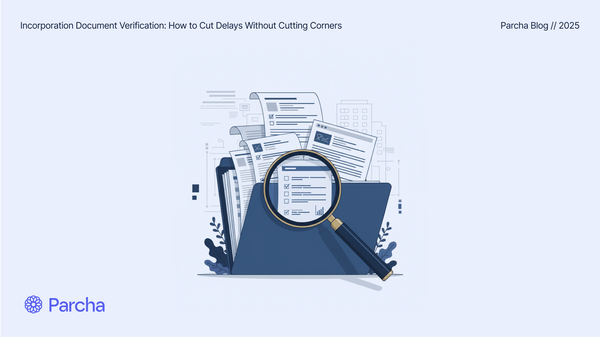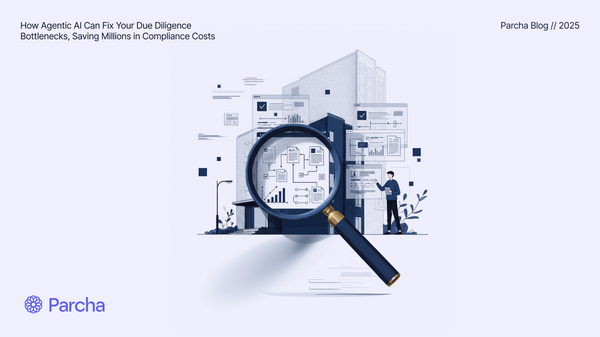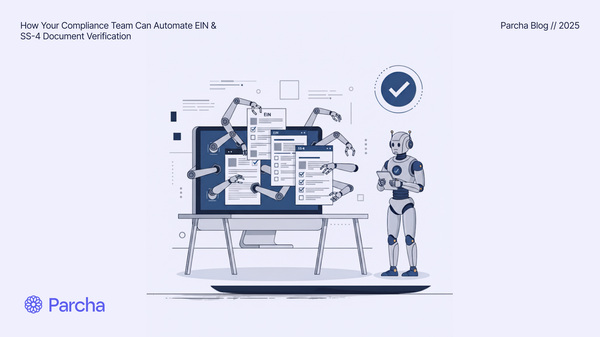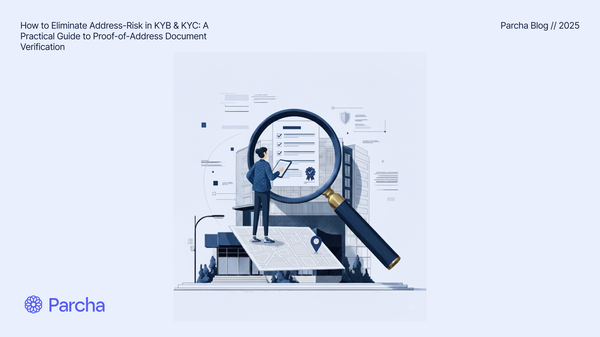Part 4 - Agentic AI: Built with Guardrails, for Compliance
This is Part 4 of our series The Compliance Arms Race where we discuss how Agentic AI's transparency and chain of thought reasoning makes it an excellent fit for automating compliance workflows.
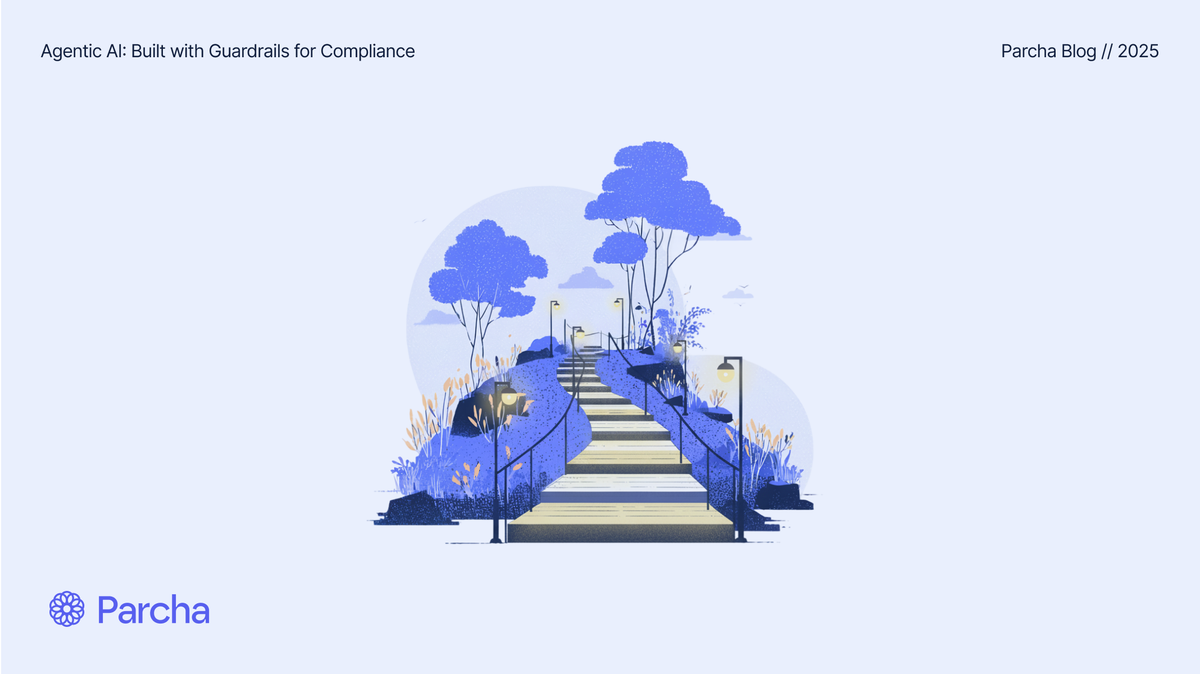
As a compliance or risk leader, you’ve likely felt the tension between regulatory expectations and the realities of rapid customer onboarding.
Regulators want clear proof of how decisions are made. Yet, your analysts are often buried in manual document reviews, chasing down incomplete ownership structures, or verifying mismatched IDs across jurisdictions.
A single oversight can mean hefty fines or reputational damage.
That’s where agentic AI comes in. It’s AI built with compliance guardrails at its core. Instead of a “black box,” it offers full explainability, audit trails, and data lineage. While also automating the repetitive checks that slow your team down.
Isn’t it time your compliance tools worked as hard, and as transparently, as your team?
The Need for Explainability and Data Lineage in Compliance AI
As a compliance leader, do you face mounting pressure to show exactly how KYC, KYB, and AML decisions are made?
Legacy AI can often act like a “black box,” soaring speed at the expense of auditability.
Agentic AI shifts the paradigm, offering you decision traceability through rich metadata (source, timestamp, model confidence) and natural-language reasoning. For example:
“Flagged for beneficial-ownership link to a sanctioned party (Source: Corporate Registry; Date: 2024-07-15; Confidence: 95%).”
Leading AI platforms like Parcha empower you with features tailored for real-world compliance:
- Detailed audit logs that capture every input-output pair and decision rationale.
- AML alert screening and resolution that slashes false positives by up to 90%, while offering explainable, source-linked outcomes.
When you onboard a new vendor, for instance, the system logs every check: ID document verification, sanctions and PEP screening, adverse-media review. All with plain-English explanations, timestamps, and data origins.
Should auditors ask why a case was cleared or flagged, you need simply walk them through each step.
Compliance Impact:
- Builds confidence in internal and external audit workflows
- Accelerates reviews without compromising defensibility
- Empowers you to demonstrate not just what was decided, but how and why with clarity and credibility
Private-by-Design Architecture & Guardrails
Transparency is only half the battle, how your AI is architected matters just as much. Without strict data isolation and policy controls, you risk breaching contractual commitments. Or, worse, exposing sensitive customer data across boundaries.
Agentic AI, when designed with privacy guardrails, can help you maintain control:
- Strict isolation: Each client operates in a dedicated environment, with data never spilling across tenants.
- Granular access: You decide who can view, escalate, or approve cases, supported by SSO and agent-level permissions.
- Immutable rules: Your escalation thresholds and policy definitions hold firm. The AI cannot “freelance” or drift into unsanctioned behavior.
Many newer platforms now offer this kind of security-first design. For instance, enterprise-grade solutions are SOC 2 Type II certified and run entirely within your security perimeter. That means your data, whether tied to PEP screening, sanctions alerts, or adverse media, never leaves your environment.
Example: Imagine your bank’s risk team requires human escalation for any PEP match above 80% confidence. With guardrails in place, the AI will flag but never bypass your rule.
Compliance Impact:
- Protects against cross-contamination risks
- Demonstrates strong alignment with regulators’ expectations on data handling
- Gives you confidence that your AI works inside your compliance perimeter, never outside it
Real-Time Audit Logs & Human-In-The-Loop Oversight
In the financial sector, auditability isn’t optional. It’s an operational requirement. Regulators expect you to show, step by step, how every decision aligns with your policy and risk framework.
Just saying ‘the system flagged this’ won’t be enough. You need logs that map each action back to logic you can defend.
Agentic AI gives you that defensibility. Each decision is automatically recorded, capturing:
- Who triggered the agent
- Which data sources were accessed
- What logic was applied
- Which remediation was recommended
Logs are structured for regulatory review, complete with reasoning chains that auditors can follow without technical translation.
At the same time, you remain firmly in control. Routine checks (like sanctions screening, adverse media, and ID validation) are handled by the AI. But when the system encounters edge cases or high-risk matches, it escalates to your team with full context preserved.
Think of it as a copilot, not an autopilot. Your analysts make the final call, but the AI ensures speed, consistency, and a clear trail of evidence.

Let’s say the agentic AI detects a complex beneficial-ownership link to a sanctioned entity.
It will log the full reasoning chain, timestamps, and sources. Then route the case to you for human confirmation against your escalation threshold.
Regulatory Compliance by Design
Frameworks like BSA/AML, KYC, and GDPR require your systems to be secure, auditable, and built with guardrails from the ground up. Missteps are costly. Look at the 2024 enforcement action against Evolve Bank & Trust, which underscored the risks of automating customer onboarding without adequate compliance safeguards. The Federal Reserve issued a cease-and-desist enforcement action against Evolve after examinations revealed critical deficiencies in its anti-money laundering (AML), risk management, and consumer compliance programs, particularly around its fintech partnerships.
Agentic AI is changing that by putting compliance first. Instead of bolting on controls after deployment, these systems are architected with:
- Full traceability: every action is logged, explained, and tied back to policy.
- Human oversight: high-risk or ambiguous cases are escalated with full context intact.
- Configurability: you can adapt workflows to meet your internal risk thresholds and regional obligations.
Many platforms now encourage pre-deployment regulatory review. That means you, and even regulators, can review the decision logic and escalation workflows before going live. This helps reduce surprises during audits and exams.
Example: With Parcha’s Agent Hub, you can configure agents to enforce your internal compliance policies from the outset. For instance, if your risk framework requires escalation of onboarding cases from high-risk jurisdictions or industries, you can set those thresholds directly in Agent Hub. Each agent operates within your defined rules, ensuring that a case involving, say, a customer from a sanctioned geography is automatically flagged and routed for human review. Because Parcha logs every input, decision, and escalation, you gain both operational speed and a defensible audit trail. Once deployed, those rules remain locked and tamper-proof, preventing AI drift or unauthorized overrides.
Compliance Impact:
- Less regulatory friction during audits and exams
- Greater trust with regulators through policy-aligned automation
- A defensible foundation for scaling compliance without sacrificing control
Practical Steps for Compliance Leaders
Adopting agentic AI doesn’t mean flipping a switch. It’s a phased process that builds trust and defensibility at each step. A proven framework looks something like this:
- Start small: Pilot low-risk use cases such as ID verification or sanctions screening before expanding to higher-stakes decisions.
- Engage regulators early: Use explainable audit logs to walk supervisors through agent logic before deployment, reducing surprises later.
- Monitor results: Track metrics like accuracy, escalation rates, and false-positive reductions to ensure the system performs as expected.
- Iterate & scale: Refine decision logic through feedback loops, then extend AI to complex workflows like beneficial-ownership checks.
A bank, for instance, can begin with automated sanctions screening. Once they’ve achieved a 70% drop in false positives (with full auditability), they might expand to KYB onboarding reviews.
How Parcha supports this journey: Agent Hub lets teams configure, test, and iterate on agents before launch. Immutable audit logs and embedded guardrails create a shared language for regulators and compliance teams, ensuring every deployment is explainable, defensible, and aligned with policy.
Conclusion: Compliance at the Speed of Trust
Agentic AI isn’t just another automation layer. It’s explainable, private, auditable, reliable, and deployable. For regulated financial firms, that balance between speed and defensibility is critical to long-term growth.
Parcha exemplifies this model, delivering agentic AI purpose-built for regulated environments through:
- SOC 2 compliance – ensuring enterprise-grade security and trust.
- Agent Hub – enabling policy-driven configuration, testing, and iteration.
- Robust audit trails – providing end-to-end transparency and defensibility.
- Human-in-the-loop oversight – keeping analysts in control of critical decisions.
The future of compliance rests on transparent systems that adapt to regulatory change, empower your analysts, and scale without eroding trust. Parcha’s agentic AI can help make that future possible.
Click here to learn more.
You can read more from The Compliance Arms Race series here:




